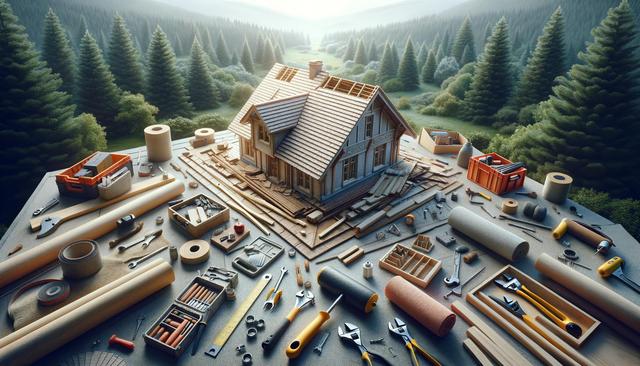Common Causes of Roof Damage
Roof damage can occur for a variety of reasons, many of which are beyond a homeowner’s control. Weather conditions are one of the most frequent culprits. Heavy rain, snow, wind, and hail can wear down roofing materials over time. Additionally, poor installation and lack of regular maintenance can accelerate deterioration. Tree branches rubbing against shingles or debris accumulating in gutters can also contribute to damage.
Some key signs of roof damage include:
- Missing or cracked shingles
- Leaks or water stains on ceilings
- Moss or algae growth
- Granules collecting in gutters
- Visible sagging or uneven rooflines
Identifying these issues early can prevent more severe problems and costly repairs in the future. Regular inspections, especially after intense storms, can help catch damage before it worsens.
When to Repair vs. When to Replace
Deciding whether to repair or replace a roof depends on the extent of the damage and the age of the roof. Minor issues like a few missing shingles or small leaks can typically be resolved with targeted repairs. However, if the damage is widespread or if the roof is approaching the end of its expected lifespan (usually 20–30 years for asphalt shingles), replacement might be more cost-effective in the long run.
Here are a few considerations to guide your decision:
- If less than 25% of the roof is damaged, repairs may be sufficient
- Frequent issues in different areas may signal systemic problems
- Older roofs are more susceptible to future damage even after repairs
- Energy efficiency and insulation may improve with a new roof
Consulting with a qualified roofing contractor can help determine the most practical and economical solution for your specific situation.
Choosing the Right Roofing Materials
When it comes to roof repair or replacement, the choice of materials plays a significant role in durability, appearance, and cost. Asphalt shingles are widely used due to their affordability and ease of installation, but other materials like metal, wood, slate, and tile offer different benefits depending on climate and architectural style.
Key factors to consider when selecting roofing materials include:
- Longevity and warranty
- Resistance to local weather conditions
- Maintenance requirements
- Environmental impact and recyclability
For example, metal roofs are known for their long lifespan and energy efficiency, while clay tiles provide excellent durability in hot climates. Balancing aesthetics with functionality is essential when making your selection.
Understanding the Roof Repair Process
Roof repair involves several steps that ensure the issue is properly addressed and that future problems are minimized. Whether you’re tackling a small patch or a major fix, the process typically includes inspection, diagnosis, material selection, and execution. Safety is a priority throughout, and professional contractors often use harnesses and scaffolding to navigate steep or high roofs.
The general steps involved in a roof repair are:
- Initial inspection to assess the scope of damage
- Removal of damaged materials
- Installation of underlayment and flashing, if needed
- Replacement of shingles or other roofing components
- Final inspection to verify the repair’s integrity
Depending on the complexity of the repair, the process could take anywhere from a few hours to several days. It’s important to work with licensed professionals who follow local building codes and offer warranties on their workmanship.
Preventive Maintenance for a Longer Roof Life
Routine maintenance is key to extending the life of your roof and minimizing repair costs. Many common problems can be prevented through simple actions taken throughout the year. Seasonal inspections, especially before winter and after storms, help identify issues like loose shingles or blocked gutters before they cause significant damage.
Effective roof maintenance tips include:
- Cleaning gutters regularly to prevent water buildup
- Trimming overhanging branches to reduce debris and abrasion
- Checking for signs of mold, algae, or moss
- Ensuring proper attic insulation and ventilation
In addition to these measures, scheduling a professional roof inspection every one to two years can provide peace of mind and catch minor issues early. Preventive care not only protects your investment but also contributes to your home’s overall energy efficiency and comfort.
Conclusion: Protecting Your Home Starts at the Top
Roof repair is an essential aspect of home maintenance that ensures safety, efficiency, and long-term value. By understanding the causes of damage, recognizing when repairs are needed, choosing appropriate materials, and committing to regular maintenance, homeowners can safeguard their property effectively. If you suspect an issue with your roof, taking timely action can prevent more costly problems down the road. Investing in your roof is ultimately an investment in the protection and longevity of your entire home.




Leave a Reply